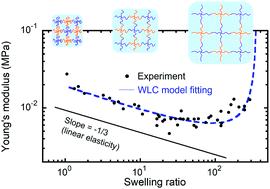Network elasticity of a model hydrogel as a function of swelling ratio: from shrinking to extreme swelling states†
Abstract
In this work, we intended to investigate the relationship between the swelling ratio Q and Young's modulus E of hydrogels from their contracted state to extreme swelling state and elucidate the underlining molecular mechanism. For this purpose, we used tetra-poly(ethylene glycol) (tetra-PEG) gel, whose network parameters are well known, as the polymer backbone, and we succeeded in tuning the swelling of the gel by a factor of 1500 times while maintaining the topological structure of the network unchanged, using an approach combining a molecular stent method and a PEG dehydration method. A master curve of Q–E, independent of the method of obtaining Q, was obtained. Using the worm-like chain model, the experimentally determined master curve can be well reproduced. We also observed that the uniaxial stress–strain curve of the hydrogel can be well predicted by the worm-like chain model using the structure parameters determined from the fitting of the Q–E experimental curve.



 Please wait while we load your content...
Please wait while we load your content...